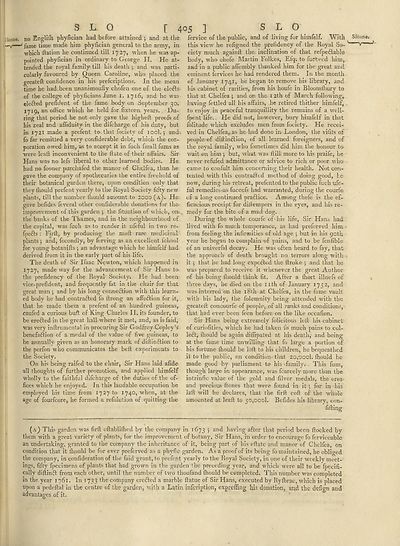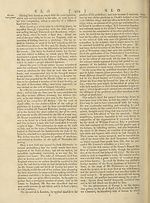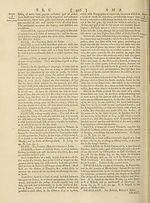Encyclopaedia Britannica, or, a Dictionary of arts, sciences, and miscellaneous literature : enlarged and improved. Illustrated with nearly six hundred engravings > Volume 19, Scripture-SUG
(449) Page 405
Download files
Complete book:
Individual page:
Thumbnail gallery: Grid view | List view

S L Q
r 405 j
S L O
'wane, no EnglHh phyfician had before attained 5 and at the
'-y—-'fame time made him phyfician general to the army, in
which llation he continued till 1727, when he was ap¬
pointed phyfician in ordinary to George II. He at¬
tended the royal family till his death j and wras partis
cularly favoured by Queen Caroline, who placed the
greateft confidence in his preferiptions. In the mean
time he had,been unanimoufiy chofen one of the clefts
of the college of phyficians June 1. 1716, and he was
elefted prefident of the fame body on September 30.
1719, an office which he held for fixteen years.. Du¬
ring that period he not only gave the higheft proofs of
his zeal and affiduity in the difcharge of his duty, but
in 1721 made a prefent to that fociety of iool.-, and:,
fo far remitted a very confiderable debt, which the cor¬
poration owed him, as to accept it in fuch fmall fums as
were leaft inconvenient to the ftate of their affairs. Sir
Hans was no lefs liberal to other learned bodies. He
had no fooner purchafed the manor of Ghelfea, than he
gave the company of apothecaries the entire freehold of
their botanical garden there, upon condition only that
they thould prefent yearly to the Royal Society fifty new
plants, till the number thould amount to 2000 (a). He
gave befides feveral other confiderable donations for the-
improvement of this garden 5 the fit nation of which, on
the banks of the Thames, and in the neighbourhood of
the capital, was fuch as to render it ufeful in two re-
fpefts : Firft, by producing the moft rare medicinal
plants j and, fecondly, by ferving as an excellent fchool
for young botanifts •, an advantage which he himfelf had
derived from it in the early part of his life.
The death of Sir Ifaac Newton, which happened in
1727, made way for the advancement of Sir Hans to
the prefidency of the Royal Society. He had been
vice-prefident, and frequently fat in the chair for that
great man j and by his long connection with this learn¬
ed body he had contrafted fo ftrong an affeftion for it,
that he made them a prefent of an hundred guineas^
caufed a curious buff of King Charles II. its founder, to
be erefted in the great hall where it met, and, as is faid,
was very inftrumental in procuring Sir Godfrey Copley’s
benefaftion of a medal of the value of five guineas, to
be annually given as an honorary mark of diftinftion to
the perfon who communicates the belt experiments to
the S ociety.
On his being raifed to the chair, Sir Hans laid afide
all thoughts of further promotion, and applied himfelf
wffiolly to the faithful difcharge of the duties of the of¬
fices which he enjoyed. In this laudable occupation he
employed his time from 1727 to 1740, when, at the
age of fourfeore, he formed a refolution of quitting the
fervice of the public, and of living for himfelf. With
this view he refigned the prelidency of the Royal So¬
ciety much againll the inclination of that refpeftable
body, who chofe Martin Folkes, Efq: to fucceed him,
and in a public afl’embly thanked him for the great and
eminent lerviees he had rendered them. In the month
of January 174.1, he began to remove his library, and
his cabinet of rarities, from his houfe in Bloomfbury to
that at Chelfea; and on the 12th of March following,
having fettled all his affairs, he retired thither himfelf,
to enjoy in peaceful tranquillity the remains of a well-
fpent life.. He did not, however, bury himfelf in that
folitude which excludes men from fociety. He recei¬
ved in Chelfea^as he had done in London, the vifits of
people of dillinftion, of all learned foreigners, and of
the royal family, v'ho fometimes did him the honour to
wait on him 5 but, what was ftill more to his praife, he
never refufed admittance or advice to rich or poor who
came to confult him concerning,their health. Not con¬
tented with this contrafted method of doing good, he
now, during his retreat, prefented to the public fuch ufe¬
ful remedies-as fuccefs had warranted, during the eourfe
of a long continued praftice. Among thefe is the ef¬
ficacious receipt for diiiempers in the eyes, and his re¬
medy for the bite of a mad dog.
During the whole courfe of- his life, Sir Hans had
lived with fo much temperance, as had preferved him ■
from feeling, the infirmities of old age ; but in his 90th
year he began to complain of pains, and to be fenfible
of an univerfal decay. He was often heard to fay, that
the approach of death brought no terrors along with .
it ; that he had long expefted the rtroke ; and that he
was prepared to receive it whenever the great Author
of his being fiiould think fit. After a thort illnefs of
three days, he died on the nth of January 1752, and
was interred on the 18th at Chelfea, in the fame vault
with his lady, the folemnity being attended with the
greateft; concourfe of people, of all ranks and conditions,
that had ever been feen before on the like oecafion.
Sir Hans being extremely felicitous left his cabinet
of curiofities, which he had taken fo much pains to eol-
left, fliould be again diffipated at his death, and being
at the fame time unwilling that fo large a portion of
his fortune ffiould be loft to his children, he bequeathed
it to the public, on condition that 20,oool. ffiould be
made good by parliament to his -family. . This fum,
though large in appearance, was fcarcely more than the
intrinfic value of the gold and filver medals, the ores
and precioas ftones that were found in it ; for in his
iaft will he declares, that the firft coft of the whole
amounted at leaft to 50,000!. Befides his library, con-
fifting
Sloane.
(a) This garden was firft eftabliftied by the company in 1673 ? anc^ having after that period been flocked by
them with a great variety of plants, for the improvement of botany, Sir Hans, in order to encourage fo ferviceable
an undertaking, granted to the company the inheritance of it, being part of his eftate and manor of Chelfea, on
condition that it ffiould be for ever preferved as a phyfic garden. As a proof of its being fo maintained, he obliged
the company, in confideration of the faid grant, to prefent yearly to the Royal Society, in one of their weekly meet¬
ings, fifty fpecimens of plants that had grown in the garden the preceding year, and which wrere all to be fpecifi-
cally diftinft from each other, until the number of two thoufand ffiould be completed. This number was completed
in the year 1761. In 1733 the company erefted a marble ftatue of Sir Hans, executed by Ryffirac, which is placed
upon a pedeftal in the centre of the garden, with a Latin infeription, exprefting his donation, and the defign and
advantages of it.
r 405 j
S L O
'wane, no EnglHh phyfician had before attained 5 and at the
'-y—-'fame time made him phyfician general to the army, in
which llation he continued till 1727, when he was ap¬
pointed phyfician in ordinary to George II. He at¬
tended the royal family till his death j and wras partis
cularly favoured by Queen Caroline, who placed the
greateft confidence in his preferiptions. In the mean
time he had,been unanimoufiy chofen one of the clefts
of the college of phyficians June 1. 1716, and he was
elefted prefident of the fame body on September 30.
1719, an office which he held for fixteen years.. Du¬
ring that period he not only gave the higheft proofs of
his zeal and affiduity in the difcharge of his duty, but
in 1721 made a prefent to that fociety of iool.-, and:,
fo far remitted a very confiderable debt, which the cor¬
poration owed him, as to accept it in fuch fmall fums as
were leaft inconvenient to the ftate of their affairs. Sir
Hans was no lefs liberal to other learned bodies. He
had no fooner purchafed the manor of Ghelfea, than he
gave the company of apothecaries the entire freehold of
their botanical garden there, upon condition only that
they thould prefent yearly to the Royal Society fifty new
plants, till the number thould amount to 2000 (a). He
gave befides feveral other confiderable donations for the-
improvement of this garden 5 the fit nation of which, on
the banks of the Thames, and in the neighbourhood of
the capital, was fuch as to render it ufeful in two re-
fpefts : Firft, by producing the moft rare medicinal
plants j and, fecondly, by ferving as an excellent fchool
for young botanifts •, an advantage which he himfelf had
derived from it in the early part of his life.
The death of Sir Ifaac Newton, which happened in
1727, made way for the advancement of Sir Hans to
the prefidency of the Royal Society. He had been
vice-prefident, and frequently fat in the chair for that
great man j and by his long connection with this learn¬
ed body he had contrafted fo ftrong an affeftion for it,
that he made them a prefent of an hundred guineas^
caufed a curious buff of King Charles II. its founder, to
be erefted in the great hall where it met, and, as is faid,
was very inftrumental in procuring Sir Godfrey Copley’s
benefaftion of a medal of the value of five guineas, to
be annually given as an honorary mark of diftinftion to
the perfon who communicates the belt experiments to
the S ociety.
On his being raifed to the chair, Sir Hans laid afide
all thoughts of further promotion, and applied himfelf
wffiolly to the faithful difcharge of the duties of the of¬
fices which he enjoyed. In this laudable occupation he
employed his time from 1727 to 1740, when, at the
age of fourfeore, he formed a refolution of quitting the
fervice of the public, and of living for himfelf. With
this view he refigned the prelidency of the Royal So¬
ciety much againll the inclination of that refpeftable
body, who chofe Martin Folkes, Efq: to fucceed him,
and in a public afl’embly thanked him for the great and
eminent lerviees he had rendered them. In the month
of January 174.1, he began to remove his library, and
his cabinet of rarities, from his houfe in Bloomfbury to
that at Chelfea; and on the 12th of March following,
having fettled all his affairs, he retired thither himfelf,
to enjoy in peaceful tranquillity the remains of a well-
fpent life.. He did not, however, bury himfelf in that
folitude which excludes men from fociety. He recei¬
ved in Chelfea^as he had done in London, the vifits of
people of dillinftion, of all learned foreigners, and of
the royal family, v'ho fometimes did him the honour to
wait on him 5 but, what was ftill more to his praife, he
never refufed admittance or advice to rich or poor who
came to confult him concerning,their health. Not con¬
tented with this contrafted method of doing good, he
now, during his retreat, prefented to the public fuch ufe¬
ful remedies-as fuccefs had warranted, during the eourfe
of a long continued praftice. Among thefe is the ef¬
ficacious receipt for diiiempers in the eyes, and his re¬
medy for the bite of a mad dog.
During the whole courfe of- his life, Sir Hans had
lived with fo much temperance, as had preferved him ■
from feeling, the infirmities of old age ; but in his 90th
year he began to complain of pains, and to be fenfible
of an univerfal decay. He was often heard to fay, that
the approach of death brought no terrors along with .
it ; that he had long expefted the rtroke ; and that he
was prepared to receive it whenever the great Author
of his being fiiould think fit. After a thort illnefs of
three days, he died on the nth of January 1752, and
was interred on the 18th at Chelfea, in the fame vault
with his lady, the folemnity being attended with the
greateft; concourfe of people, of all ranks and conditions,
that had ever been feen before on the like oecafion.
Sir Hans being extremely felicitous left his cabinet
of curiofities, which he had taken fo much pains to eol-
left, fliould be again diffipated at his death, and being
at the fame time unwilling that fo large a portion of
his fortune ffiould be loft to his children, he bequeathed
it to the public, on condition that 20,oool. ffiould be
made good by parliament to his -family. . This fum,
though large in appearance, was fcarcely more than the
intrinfic value of the gold and filver medals, the ores
and precioas ftones that were found in it ; for in his
iaft will he declares, that the firft coft of the whole
amounted at leaft to 50,000!. Befides his library, con-
fifting
Sloane.
(a) This garden was firft eftabliftied by the company in 1673 ? anc^ having after that period been flocked by
them with a great variety of plants, for the improvement of botany, Sir Hans, in order to encourage fo ferviceable
an undertaking, granted to the company the inheritance of it, being part of his eftate and manor of Chelfea, on
condition that it ffiould be for ever preferved as a phyfic garden. As a proof of its being fo maintained, he obliged
the company, in confideration of the faid grant, to prefent yearly to the Royal Society, in one of their weekly meet¬
ings, fifty fpecimens of plants that had grown in the garden the preceding year, and which wrere all to be fpecifi-
cally diftinft from each other, until the number of two thoufand ffiould be completed. This number was completed
in the year 1761. In 1733 the company erefted a marble ftatue of Sir Hans, executed by Ryffirac, which is placed
upon a pedeftal in the centre of the garden, with a Latin infeription, exprefting his donation, and the defign and
advantages of it.
Set display mode to:
![]() Universal Viewer |
Universal Viewer | ![]() Mirador |
Large image | Transcription
Mirador |
Large image | Transcription
Images and transcriptions on this page, including medium image downloads, may be used under the Creative Commons Attribution 4.0 International Licence unless otherwise stated. ![]()
| Permanent URL | https://digital.nls.uk/192701119 |
|---|
| Attribution and copyright: |
|
|---|
| Description | Ten editions of 'Encyclopaedia Britannica', issued from 1768-1903, in 231 volumes. Originally issued in 100 weekly parts (3 volumes) between 1768 and 1771 by publishers: Colin Macfarquhar and Andrew Bell (Edinburgh); editor: William Smellie: engraver: Andrew Bell. Expanded editions in the 19th century featured more volumes and contributions from leading experts in their fields. Managed and published in Edinburgh up to the 9th edition (25 volumes, from 1875-1889); the 10th edition (1902-1903) re-issued the 9th edition, with 11 supplementary volumes. |
|---|---|
| Additional NLS resources: |
|

